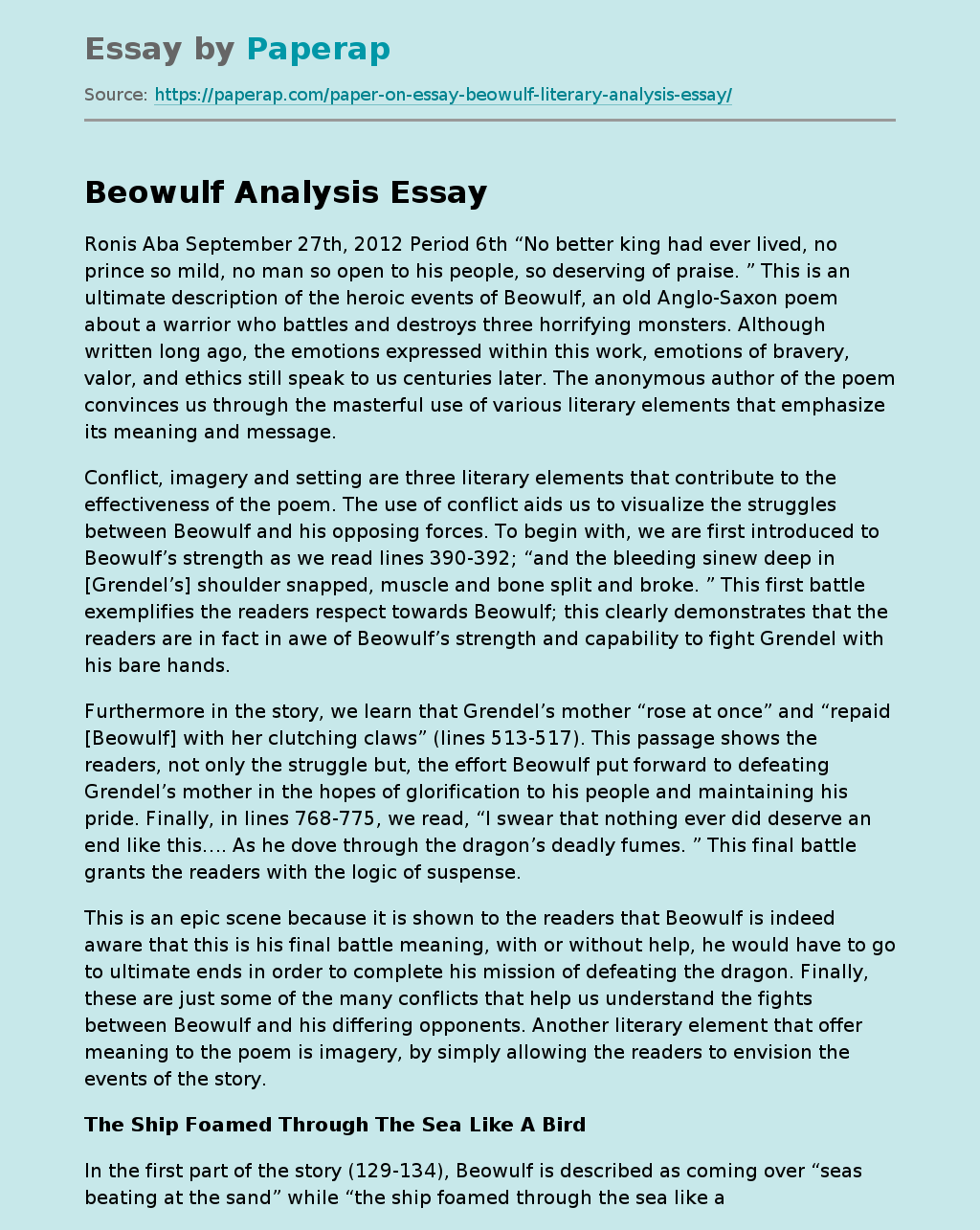Beowulf Analysis
Ronis Aba September 27th, 2012 Period 6th “No better king had ever lived, no prince so mild, no man so open to his people, so deserving of praise. ” This is an ultimate description of the heroic events of Beowulf, an old Anglo-Saxon poem about a warrior who battles and destroys three horrifying monsters. Although written long ago, the emotions expressed within this work, emotions of bravery, valor, and ethics still speak to us centuries later. The anonymous author of the poem convinces us through the masterful use of various literary elements that emphasize its meaning and message.
Conflict, imagery and setting are three literary elements that contribute to the effectiveness of the poem. The use of conflict aids us to visualize the struggles between Beowulf and his opposing forces. To begin with, we are first introduced to Beowulf’s strength as we read lines 390-392; “and the bleeding sinew deep in [Grendel’s] shoulder snapped, muscle and bone split and broke. ” This first battle exemplifies the readers respect towards Beowulf; this clearly demonstrates that the readers are in fact in awe of Beowulf’s strength and capability to fight Grendel with his bare hands.
Furthermore in the story, we learn that Grendel’s mother “rose at once” and “repaid [Beowulf] with her clutching claws” (lines 513-517). This passage shows the readers, not only the struggle but, the effort Beowulf put forward to defeating Grendel’s mother in the hopes of glorification to his people and maintaining his pride. Finally, in lines 768-775, we read, “I swear that nothing ever did deserve an end like this….
As he dove through the dragon’s deadly fumes. ” This final battle grants the readers with the logic of suspense.
This is an epic scene because it is shown to the readers that Beowulf is indeed aware that this is his final battle meaning, with or without help, he would have to go to ultimate ends in order to complete his mission of defeating the dragon. Finally, these are just some of the many conflicts that help us understand the fights between Beowulf and his differing opponents. Another literary element that offer meaning to the poem is imagery, by simply allowing the readers to envision the events of the story.
The Ship Foamed Through The Sea Like A Bird
In the first part of the story (129-134), Beowulf is described as coming over “seas beating at the sand” while “the ship foamed through the sea like a bird. ” This scene truly guides the readers to admire the vivid description of how proud and tough the ship looks. This ship in this case, becomes a metonymy for Beowulf himself, who is certainly proud and strong, resulting in the readers’ admiration. Additional imagery is used describing the mere, or lake, discussed above, with “storms [an] waves splash[ing] towards the sky, as dark as the air as black as the rain that the heavens weep” (440-442).
This clearly illustrates how dreadful Grendel and his mothers’ home is. It intensely aids us to picture how grotesquely unpleasant the lake actually is. Near the end of the tale (lines 651-653], Beowulf “[strides] with his shield at his side and a mail shirt of his breast….. Toward the tower, under the rocky cliffs. ” While Beowulf awaits the battle, the description of his armor and the details of each entry help us to respect how ready he is for his concluding battle. Even as an elderly man, Beowulf is a hero beyond compare.
In closing, the use of imagery greatly enriches the readers’ experience of this heroic epic. Evidently, the setting of Beowulf helps the readers to better understand the cultures and events that occur in the story. In lines 60-63, the mead hall (Herot) is described as “[standing] empty, and stay[ing] deserted for years, twelve winters. ” This makes the readers feel and understand the seriousness of Grendel’s attack. Before Grendel, Herot was described as a beautiful and happy place, and so the readers feel terrible regret when it is destroyed by the creature.
Later in the story, we are shown the lair under which Grendel and his mother lives: “secret places, windy cliffs” and a lake which “at night….. Burns like a torch” (424-433). This passage shows the readers the monstrous, awful conditions of where the monsters lived. It also causes us to feel disgust and revulsion at their horrible habitat. Finally, in the episode with the dragon, its cave is depicted as a “hidden entrance” with “a streaming current of fire and smoke block[ing] the passage” (lines 659-661). The cave is intimidating, helping the readers to believe that the upcoming battle will be a real challenge for Beowulf.
And it turns out to be so as the powerful dragon ultimately causes the hero’s death. Evidently, these settings, along with others, make the stories come alive for the readers. The poet effectively combines the literary elements conflict, imagery and setting to show the reader the qualities of an Anglo-Saxon warrior and hero. To the old English people, no one was more praise worthy than Beowulf, Despite it being written over a thousand years ago, Beowulf shows one important detail of what it takes to truly be a hero, a standard to which we can still relate to today, perhaps more powerfully than ever.
Beowulf Analysis. (2019, Dec 05). Retrieved from https://paperap.com/paper-on-essay-beowulf-literary-analysis-essay/

